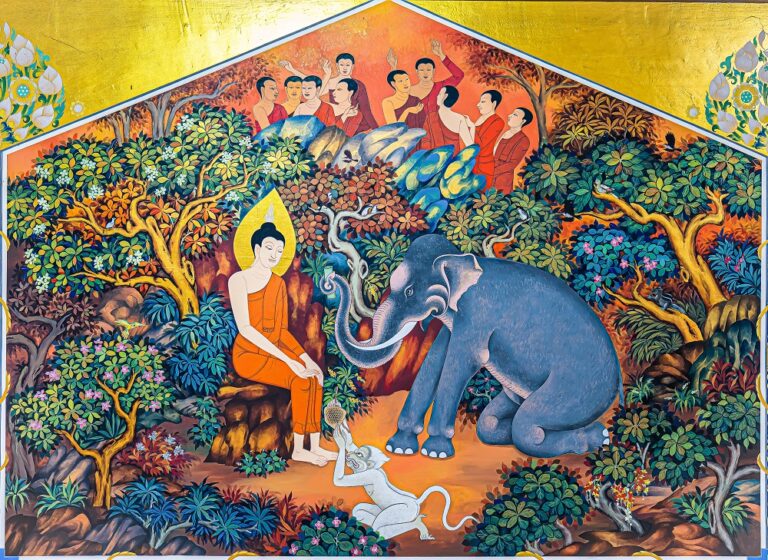
THE QUARREL AT KOSAMBI
Nine years after his Enlightenment, the Buddha was living in the monastic community at Kosambi.
One day, a monk left his washing water near the toilet. Another monk accused him of breaking the rules. The offending monk argued that he left the water accidentally, and had not intentionally broken the rules, so he had not broken the Dhamma and there was no crime. The monastery became divided on this topic, and the monks started arguing. The Buddha tried to convince them to stop, to settle the argument peacefully, but the disagreement grew. The monks would not calmly listen to each other’s viewpoints, and they violently insulted each other.
The Buddha taught the monks the six memorable qualities that bring harmony, such as committing to bodily, verbal, and mental loving-kindness in public and in private life. The Buddha also taught the monks the seven factors for self-reflection, so that they would be able to look at the matters under discussion objectively, freeing the mind from its obsessions. Yet none of this did any good, and the monks still argued.
Finally, the Buddha decided to leave, saying: “It is better to walk alone, there is no companionship with fools. One should walk alone and do no evil, peacefully like an elephant in the woods.”
He took his bowl and his robes, and went to Eastern Bamboo Park, where he spoke with three monks who were living there peacefully. Then, he went to Parileyyaka Forest, home of an elephant named Parileyya, and settled at the foot of a beautiful sala tree.
Just like the Buddha, Parileyya had grown tired of living with his herd, and all the annoyances the other elephants caused him. So, he decided to leave and live on his own in the forest. When the Buddha came, Parileyya broke a branch from a tree, and used it as a broom to sweep the ground for him. He brought fruit for the Buddha, and fresh drinking water. When the Buddha required a bath, Parileyya used his trunk to build a fire out of sticks, and heated the water for him.
When the Buddha went to the village for alms, Parileyya walked with him. He fanned the Buddha with the branch of a tree. (As seen in this mural) At night, the elephant protected the Buddha from predators by walking back and forth with a big club held in his trunk. For that reason, the forest became known as the Protected Forest.
One day, a monkey saw the elephant doing these things for the Buddha, and thought to himself, “I’ll do something, too!” As he was swinging through the branches of the trees, he saw a honeycomb. He broke off a piece, placed it on a plantain leaf, inspected and cleaned it, and brought it to the Buddha, as we can see in this painting. The Buddha ate the honeycomb.
When the villagers went to the monastery to visit the Buddha, they discovered that he had left due to an argument among the monks. The villagers were angry with the monks, and stopped giving them food. They demanded that the monks stop arguing and go find the Buddha. Without food, the monks went hungry and quickly stopped arguing. When the rainy season ended, the very hungry monks went to find the Buddha, to ask his pardon.
The Buddha asked them to listen calmly to each other, and they did so. Despite their previous behaviour, the Buddha trusted them to find the truth for themselves, based on the Dhamma. The situation was finally resolved, and everyone returned to the monastery in peace.
This story represents the ideas that underpin the Buddhist idea of the “sangha,” or monastic community. A community is made up of flawed people. It is therefore destined to disappoint us, but how we respond to disagreements is a key part of the practice of Buddhism. Right and wrong matter less than how we respond when arguments arise: by reacting angrily, we are already in the wrong.